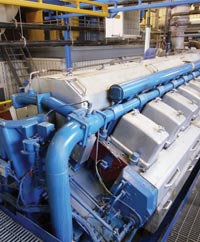 During Superstorm Sandy, New York City experienced its worst storm surge in nearly 200 years. Underground electrical distribution equipment located in flood-prone areas was swamped, resulting in the most extensive storm-related power outage in the city's history. Approximately 250,000 customers in lower Manhattan were left without power.
During Superstorm Sandy, New York City experienced its worst storm surge in nearly 200 years. Underground electrical distribution equipment located in flood-prone areas was swamped, resulting in the most extensive storm-related power outage in the city's history. Approximately 250,000 customers in lower Manhattan were left without power.
While customers served by ConEd’s overhead distribution system had their service restored in a week or so, those served from the utility’s underground distribution system ¾ in the most densely populated parts of the city ¾ had to wait much longer. Underground distribution systems are much more difficult to repair, especially those in low-lying areas.
This experience has highlighted the need to make underground distribution systems more resilient to flood-related damage. The deployment of switchgear specially designed for subsurface application in vaults subject to flooding can help achieve this goal. This type of switchgear can continue to function indefinitely when subjected to flooding from water containing typical levels of contaminants such as salt, fertilizer, motor oil, and cleaning solvents.
High-speed fault-clearing configurations of this switchgear are available for application in networks that provide essentially interruption-free service—a fault occurring in any segment of the network is rapidly cleared and automatically isolated, but service to customer loads is not interrupted (or the interruption is minimal).
Submersible Automated Medium-Voltage Switchgear
Medium-voltage switchgear is available featuring load-interrupter switches and resettable fault interrupters installed in a gas-tight tank containing pressurized gas insulation. This type of switchgear can be furnished in submersible models that are suitable for installation in vaults subject to flooding. In these models, the tank is manufactured of Type 304L stainless steel to guard against corrosion due to the extremely harsh environmental conditions. The tank is capable of withstanding up to 10 feet (3 meters) of water above the base.
The switchgear includes a separately mounted submersible low-voltage enclosure, also manufactured of Type 304L stainless steel. The low-voltage enclosure in high-speed fault-clearing configurations houses a multifunction, microprocessor-based relay for each fault interrupter in the switchgear. A multifunction, microprocessor-based relay is also applied on each substation circuit breaker feeding the loop of switchgear units.
All current- and voltage-sensing wiring between the switchgear tank and the low-voltage enclosure is submersible as well.
High-Speed Fault-Clearing System
In this system, switchgear units are connected to each other in a loop. The relays are configured to communicate with each other through a fiber-optic cable network. The relay protection arrangement ensures that only the fault interrupters on either side of a faulted cable section open.
In closed-loop applications, both ends of the loop are fed from the same utility substation bus. With this arrangement, load will not be lost while a fault is cleared, although some utility customers will experience a voltage dip.
Open-loop applications require an open switching point in the loop. This approach enables two feeders from different substations to be interconnected. However, with this arrangement, some customers may experience a three- to four-second loss of voltage while the normally open switch is closed.
Each relay is capable of functioning as a remote terminal unit and can communicate with the utility’s SCADA master station via process automation protocols. The remote terminal unit can accept a wide variety of inputs, such as a vault personnel sensor; vault water level sensor; vault explosive gas sensor; vault temperature sensor; and transformer voltage, current, and temperature sensors.
Examples of the Application of Submersible Automated Medium-Voltage Switchgear
Several major U.S. utilities have deployed submersible medium-voltage switchgear units on selected areas of their systems, including ConEd, United Illuminating, and Oncor. High-speed fault-clearing systems are currently installed in Florida, Illinois, and California.
Eletropaulo, CEMIG, and Ampla ¾ the largest electric utilities in Brazil—as well as Chilectra, a large utility in Chile, have installed more than 500 submersible automated medium-voltage switchgear units in high-speed fault-clearing systems .Similar systems are being considered by other utilities in the region.
Roadmap Recommendations
Implementation of an automated underground distribution system typically involves a number of steps, including:
- engineering analysis to determine the ideal automation strategy for the underground distribution system
- SCADA integration, if applicable
- a communication survey if the system is to communicate with the utility’s SCADA system.
- project management
- training of utility personnel
- commissioning of the system